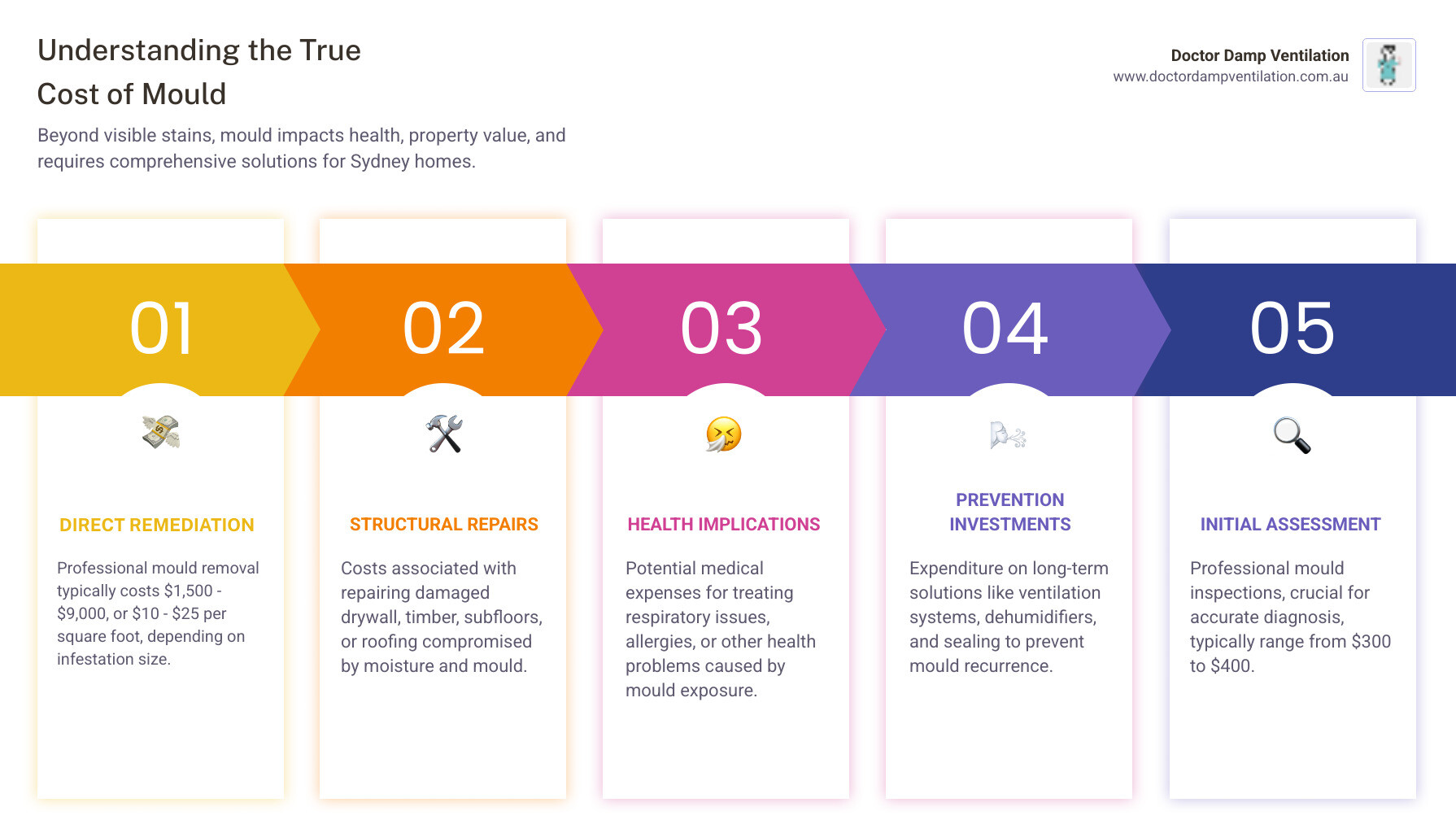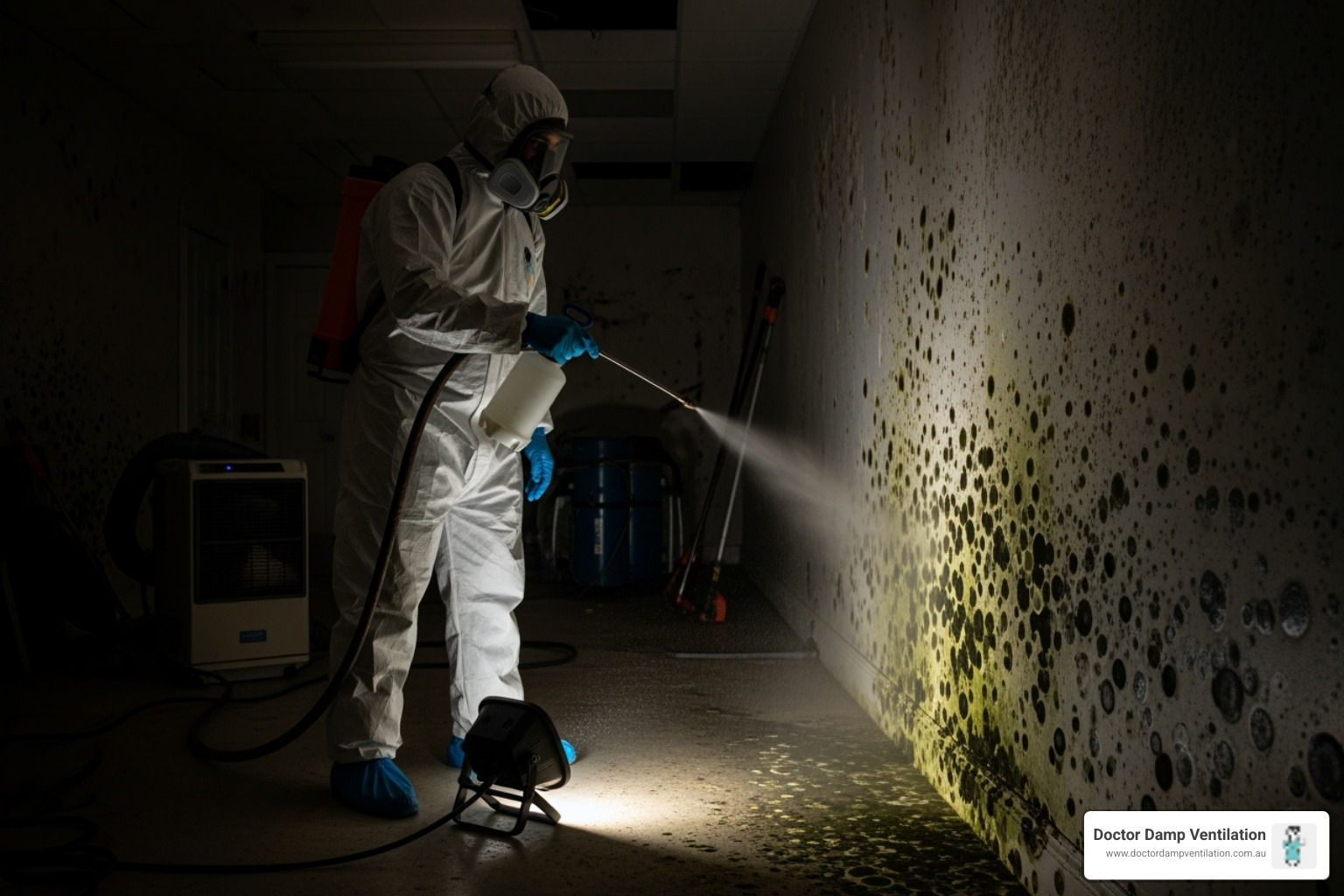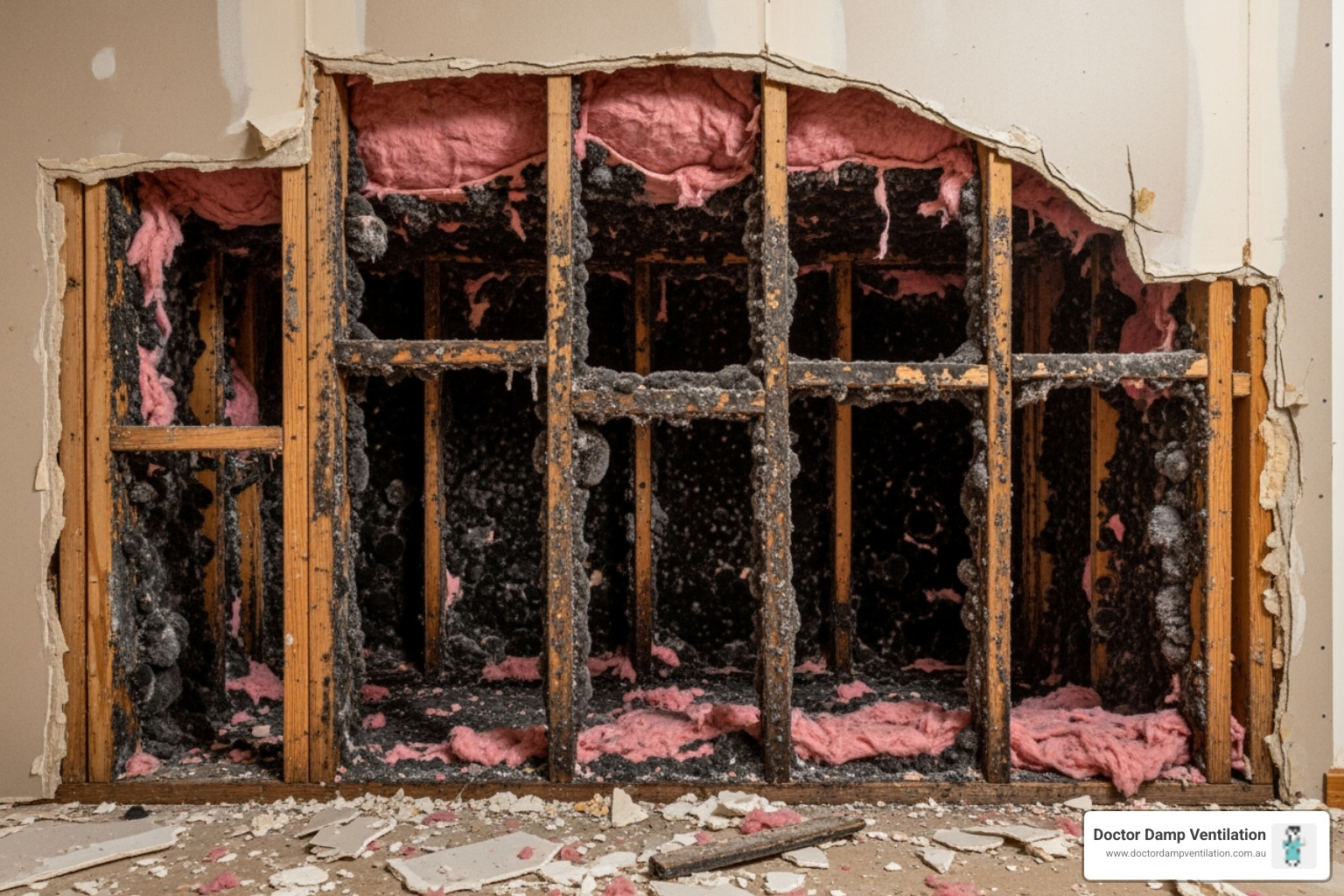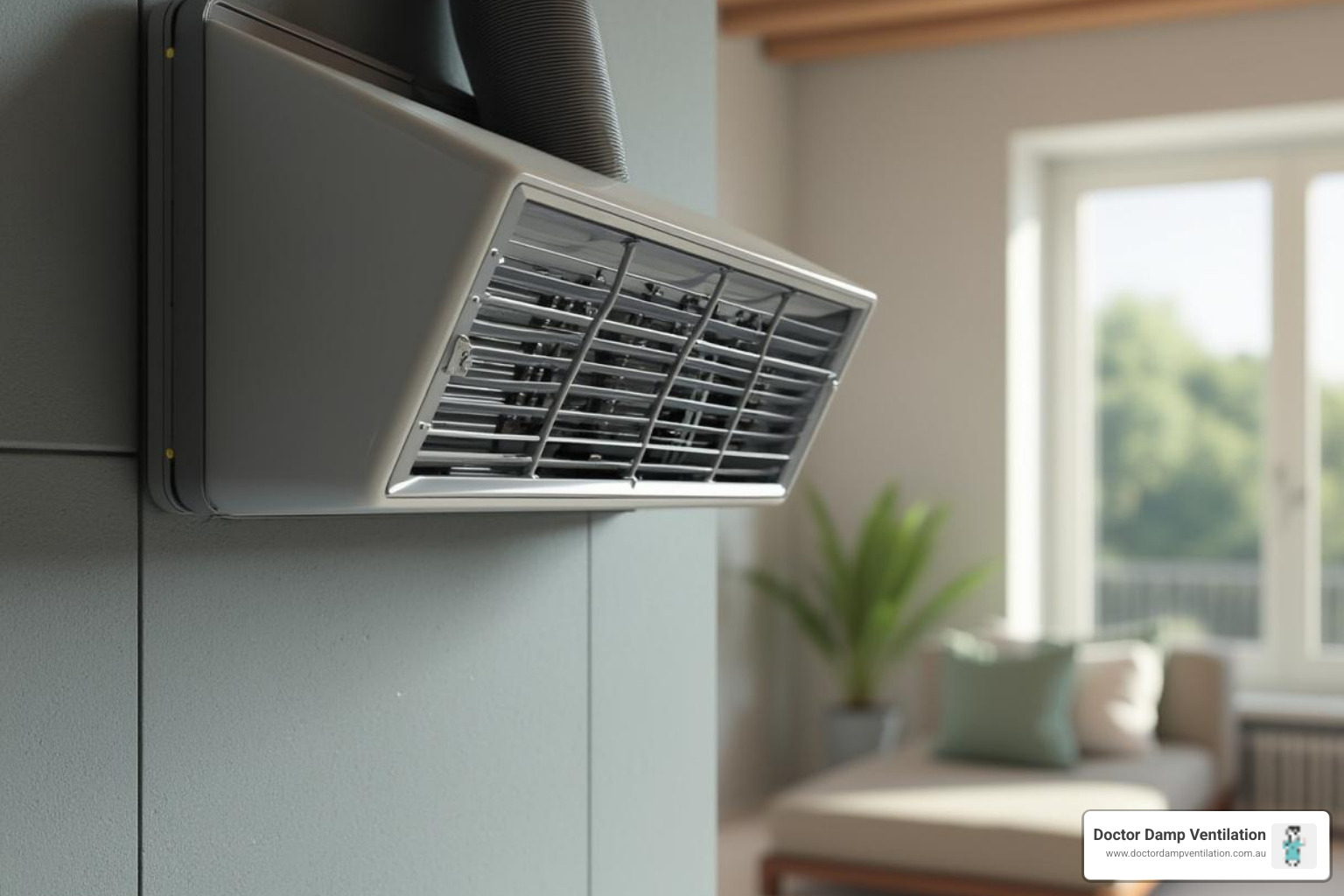Cost of Mould: Unveiling Hidden Expenses 2025
Introduction: More Than Just an Ugly Stain
When visible mould appears or a damp smell lingers, Sydney homeowners often wonder about the cost of mould. It’s more than an unsightly stain; mould carries a hidden price tag that affects your family’s health and your property’s value.
Here’s a quick look at typical mould-related costs:
- Average Professional Mould Remediation:
$3,500(ranging from$1,500to$9,000) - Small Area (up to 25 sq ft):
$700 - $6,000 - Per Square Foot:
$10 - $25 - Mould Inspection:
$300 - $400 - DIY (small areas):
$50 - $300
This guide helps homeowners understand the full financial impact of mould, from cleanup to prevention. We’ll explore why moisture issues lead to recurring problems and how to find reliable solutions for a safe home.
I’m Scott Lambert, founder of Dr. Damp. For over 20 years, I’ve helped Australians understand the true cost of mould and safeguard their homes against moisture damage with solutions that go beyond surface fixes.

Breaking Down the Average Cost of Mould Remediation in Sydney
For Sydney homeowners, professional mould removal averages around $2,230, with jobs typically falling between $1,128 and $3,450. More extensive professional remediation can range from $1,500 to $9,000, with an average of $3,500. Costs are often calculated per square foot, usually between $10 to $25. In Sydney’s humid climate, especially in coastal spots like Bondi, Coogee, and Manly, mould spreads fast. Catching it early with professional help is key to keeping the overall cost of mould manageable.
At Doctor Damp Ventilation, our Mould Removal services don’t just clear visible mould; we address the root causes to ensure it doesn’t return.

Cost by Location in Your Home
The location of the mould significantly impacts the price, as some areas are harder and more expensive to treat.
- Attic Mould Remediation: Common in older Sydney homes due to poor insulation and condensation. Costs typically range from $1,000 to $4,000 but can exceed $7,000 for severe cases. Proper Roof Ventilation is often the real solution.
- Basement and Crawl Space Mould Remediation: These spaces, found in properties from Penrith to Randwick, are prone to moisture. Basement remediation costs $500 to $3,000, while crawl spaces are similar at $500 to $2,000. A severe case needing encapsulation can hit $10,000. Effective Sub-Floor Ventilation is a crucial preventative measure.
- Bathroom Mould Remediation: Bathrooms are mould hotspots. A small patch might cost $500 to $1,000, but if mould is behind tiles or walls, the cost of mould can climb to $8,000 or more due to demolition and reconstruction.
- Wall Cavities and Drywall Mould Remediation: Hidden mould in walls is a common issue. Remediation can cost $1,000 to $20,000, depending on the spread and if structural repairs are needed. Simple drywall repair usually costs $300 to $825.
- HVAC System Mould Remediation: Mould in your air conditioning system can spread spores throughout your home. Cleaning these systems is expensive, typically ranging from $3,000 to $10,000.
- Whole-House Mould Remediation: In severe cases like after a flood, a whole-house job can cost $10,000 to $30,000. In extreme situations, the cost of mould remediation can top $40,000, which can occur in homes across Sydney, from the Eastern Suburbs to the Northern Beaches.
Cost by Severity and Size
Naturally, the larger the mould problem, the higher the bill.
- Small Area (up to 25 sq ft): For a small patch, costs range from $700 to $6,000, depending on accessibility and necessary repairs.
- Medium Area (100-300 sq ft): For a larger section, like an entire wall, remediation typically falls between $5,000 and $15,000.
- Large Area (300-1,000 sq ft): For significant infestations across multiple rooms, expect costs upwards of $15,000.
- XL Area (over 1,000 sq ft or unattended homes): In catastrophic scenarios, remediation can soar to $40,000 or more, often including significant structural repairs like replacing flooring.
Key Factors That Influence the Final Cost of Mould Treatment
Beyond location and size, several other factors influence the final cost of mould treatment. Understanding these helps you prepare and make smart decisions for your Sydney property.
Accessibility is a major factor; mould in a tight crawl space costs more to treat than on an exposed wall. The type of mould, such as black mould (Stachybotrys chartarum), can also influence safety protocols and costs, as noted by sources like Forbes. Whether mould is on porous surfaces (drywall, wood) versus non-porous surfaces (glass, metal) is also critical. Porous materials often require complete removal and replacement, increasing the overall cost of mould.
Labour costs in Sydney typically range from $75 to $100 per hour and make up about 60% of the total bill. Finally, post-remediation repairs and restoration, such as replacing drywall (often $300 to $825) or installing new flooring, will add to the total cost.

The Impact of Moisture Source on Cost
The hidden culprit behind mould is always moisture. If you don’t fix the source, mould will return, leading to a frustrating cycle of recurring expenses. This is where Doctor Damp Ventilation’s expertise in lasting solutions truly shines.
Common moisture sources include:
- Ongoing Leaks: A dripping pipe or faulty roof seal can feed a mould colony. Minor roof repairs ($350 to $1,250) are far cheaper than the eventual cost of mould remediation.
- Condensation Issues: Poor ventilation can cause condensation, creating damp conditions perfect for mould, especially in bathrooms and basements in suburbs like Newtown or Redfern.
- Rising Damp: This occurs when ground moisture travels up through walls, demanding specialised treatment to prevent chronic mould.
- Flooding Events: A burst pipe or natural flood can cause widespread water damage, leading to massive mould infestations and high remediation costs.
- Poor Ventilation: A lack of airflow is a primary cause of excess moisture. Our expertise at Doctor Damp Ventilation, particularly with sub-floor ventilation systems, is designed to combat this. We ensure proper air circulation to stop mould from forming, which is far more effective than just cleaning the visible problem.
Professional vs. DIY: A Cost and Safety Comparison
When you spot mould, you might wonder if you can clean it yourself to save money. It’s important to weigh the immediate savings against the hidden risks and long-term results to understand the true cost of mould remediation.
Here’s a quick comparison of DIY and professional mould removal:
| Factor | DIY Mould Removal | Professional Mould Remediation |
|---|---|---|
| Upfront Cost | $50 – $300 (for supplies) | $1,500 – $9,000 (average $3,500) |
| Long-Term Effectiveness | Often a temporary fix; high risk of mould coming back; doesn’t solve the main problem | Long-lasting if the root cause is fixed; full and proper treatment |
| Safety | High risk of breathing in mould spores; can be handled incorrectly | Experts use special gear, seal off areas, and have proper equipment; much safer |
| Time Commitment | Can be ongoing if mould keeps returning | Usually 1-7 days (depends on how bad the mould is) |
| Guarantee | None | Often offered by good companies |
The DIY Approach: When Is It Safe and What’s the Real Cost?
DIY cleaning is only recommended by health authorities like the EPA for very small areas (no bigger than 1 square metre). The upfront cost of mould supplies is low, around $50 to $300. However, the real cost lies in the risks. Without proper knowledge, you can spread mould spores to other parts of your home (cross-contamination), and inhaling mould can cause allergic reactions and other health issues.
Crucially, DIY cleaning doesn’t fix the underlying moisture problem. If a hidden leak or high humidity remains, the mould will almost certainly return. For homes in humid Sydney areas like Cronulla, Brighton-Le-Sands, or Dee Why, simply wiping away mould is rarely a permanent solution.
The Professional Solution: Investing in a Healthy Home
While the upfront cost of mould remediation by professionals seems higher (averaging $3,500), it’s a wise investment in your home and family’s health. We strongly recommend calling experts if the mould covers more than 1 square metre, is hidden, keeps returning, or if anyone in your home is experiencing mould-related health symptoms.
Professionals use specialised equipment like HEPA air scrubbers and containment barriers to work safely and effectively. Most importantly, they solve the root cause. Our certified technicians provide long-term solutions, like our sub-floor ventilation systems, to control moisture and stop mould from growing again. This complete approach is an investment in a Healthy Home. For families in areas like the Hills District, St George, or the Blue Mountains, professional remediation provides peace of mind, protects your home’s value, and prevents larger, more expensive problems later.
Beyond Removal: The Hidden and Preventative Cost of Mould
The cost of mould extends far beyond the initial cleanup. It includes inspections, potential insurance issues, and smart preventative investments that can save you a fortune later.

The Initial Assessment: How Much is a Mould Inspection?
A professional mould inspection diagnoses the extent of the problem and identifies the moisture source. In Sydney, a thorough inspection typically costs $300 to $400, or $700 to $900 for homes over 4,000 square feet. This includes a visual check and moisture readings. Air sampling can add another $250 to $300. An inspection is highly recommended after any water damage, if you notice a persistent musty smell, or as a pre-purchase check for properties in suburbs like Woollahra, Double Bay, or Vaucluse.
Will Homeowners Insurance Cover the Cost of Mould Remediation?
This is a tricky question. Generally, insurance might cover the cost of mould if it’s from a “sudden and accidental” event, like a burst pipe. However, mould from neglect (e.g., a slow, unfixed leak) or long-term humidity issues is usually not covered. Many policies have specific mould exclusions or coverage limits, as detailed by sources like US News. It’s crucial to check your policy’s fine print. Standard policies also don’t cover mould from natural floods; that requires a separate flood insurance policy.
The Cost of Prevention: A Smart Investment
The best way to reduce the cost of mould is to prevent it from growing in the first place. A proactive investment now can save you a huge remediation bill later.
- Humidity Control: Keep indoor humidity between 30% and 50%. A quality dehumidifier ($1,100 to $2,800) is a bargain compared to a $15,000 mould cleanup.
- Good Ventilation: Ensure bathrooms and kitchens have working exhaust fans. For homes across Sydney, from Chatswood to Mona Vale, proper airflow is vital. Our sub-floor ventilation systems are designed to tackle moisture at its source.
- Fix Leaks Immediately: A minor roof leak ($150 to $1,000) or pipe repair ($150 to $850) is a small price to pay to prevent a major mould outbreak.
- Sealing and Encapsulation: For basements and crawl spaces, consider sealing foundations ($2,250 to $7,100) or crawl space encapsulation ($1,500 to $15,000) to create a barrier against ground moisture.
- Air Purification: While not a preventative measure for growth, Air Purification can improve indoor air quality by filtering out mould spores.
- Proactive Maintenance: Simple habits like cleaning gutters and ensuring water drains away from your home pay off. For homes in diverse Sydney suburbs from Epping to Homebush, these measures are a fantastic investment.
Frequently Asked Questions about Mould Costs
It’s natural to have questions when dealing with mould, especially about the cost of mould and the remediation process. Here are answers to some common concerns.
How can you reduce mould remediation costs?
Acting quickly and proactively can keep the cost of mould remediation from spiralling.
- Act Fast: Mould can grow in as little as 48 hours on a damp surface. Addressing a damp patch or musty smell immediately can save you a fortune.
- Fix Leaks Immediately: Mould thrives on moisture. Stopping the water source is the most important step to prevent it from spreading and causing more expensive damage.
- Control Humidity: Keep indoor humidity between 30% and 50% using good ventilation, exhaust fans, and dehumidifiers.
- Get Multiple Quotes: Contact at least three professional remediation companies to compare their solutions, services, and prices to ensure you get a fair deal.
- Invest in Prevention: This is the most cost-effective long-term strategy. Proactive measures like improving your home’s ventilation are key. At Doctor Damp Ventilation, we specialise in these preventative services, addressing the root cause of moisture to save you from future remediation bills.
How long does mould removal take?
The time required depends on the size and severity of the infestation.
- Small to medium-sized jobs usually take 1 to 3 days. This includes setting up containment, removing the mould, cleaning surfaces, and drying the area.
- Large or severe infestations, such as after a flood, can take up to 5-7 days or longer. These jobs often involve more complex procedures and removing contaminated materials like drywall or insulation.
The timeline is also affected by the accessibility of the mould and any post-remediation repairs needed.
What are the signs of a hidden mould problem?
Mould often grows out of sight. Being vigilant for these signs can help you catch a problem early.
- Persistent Musty Smell: This is the most common sign. If you smell an earthy, dusty, or damp sock-like odour but see no mould, it’s likely growing somewhere hidden.
- Water Stains or Discolouration: Look for new or growing yellowish or brownish stains on walls, ceilings, or floors, as they indicate a moisture problem.
- Bubbling Paint or Wallpaper: If paint or wallpaper is bubbling, peeling, or cracking, it’s often a sign of trapped moisture underneath where mould can thrive.
- Unexplained Allergy Symptoms: If your family experiences ongoing coughing, sneezing, itchy eyes, or headaches at home that improve when you leave, it could be a reaction to airborne mould spores.
Securing a Mould-Free Future for Your Sydney Home
We’ve seen how the true cost of mould goes far beyond the remediation bill, impacting your family’s health, your home’s value, and your peace of mind. A small stain can quickly escalate into a major financial and emotional burden if left unaddressed.
At Doctor Damp Ventilation, our approach goes deeper than just cleaning visible mould. We are dedicated to fixing the root cause of moisture to ensure mould doesn’t return. Whether it’s a sub-floor ventilation issue in Glebe, rising damp in a Paddington terrace, or humidity challenges in a Coogee apartment, we have a custom solution for your Sydney property.
Our expert, non-toxic, and guaranteed mould remediation solutions are designed to protect your property’s value and ensure your family breathes easier in a healthy environment.
If you’re ready to say goodbye to mould for good, don’t hesitate. For expert advice and a lasting solution to mould in your Sydney property—whether you’re in Parramatta, Bondi, the Sutherland Shire, the Inner West, Liverpool, Blacktown, or the Northern Beaches—explore our professional Mould Removal services. Let us help you transform your house back into the safe, mould-free home it deserves to be.

